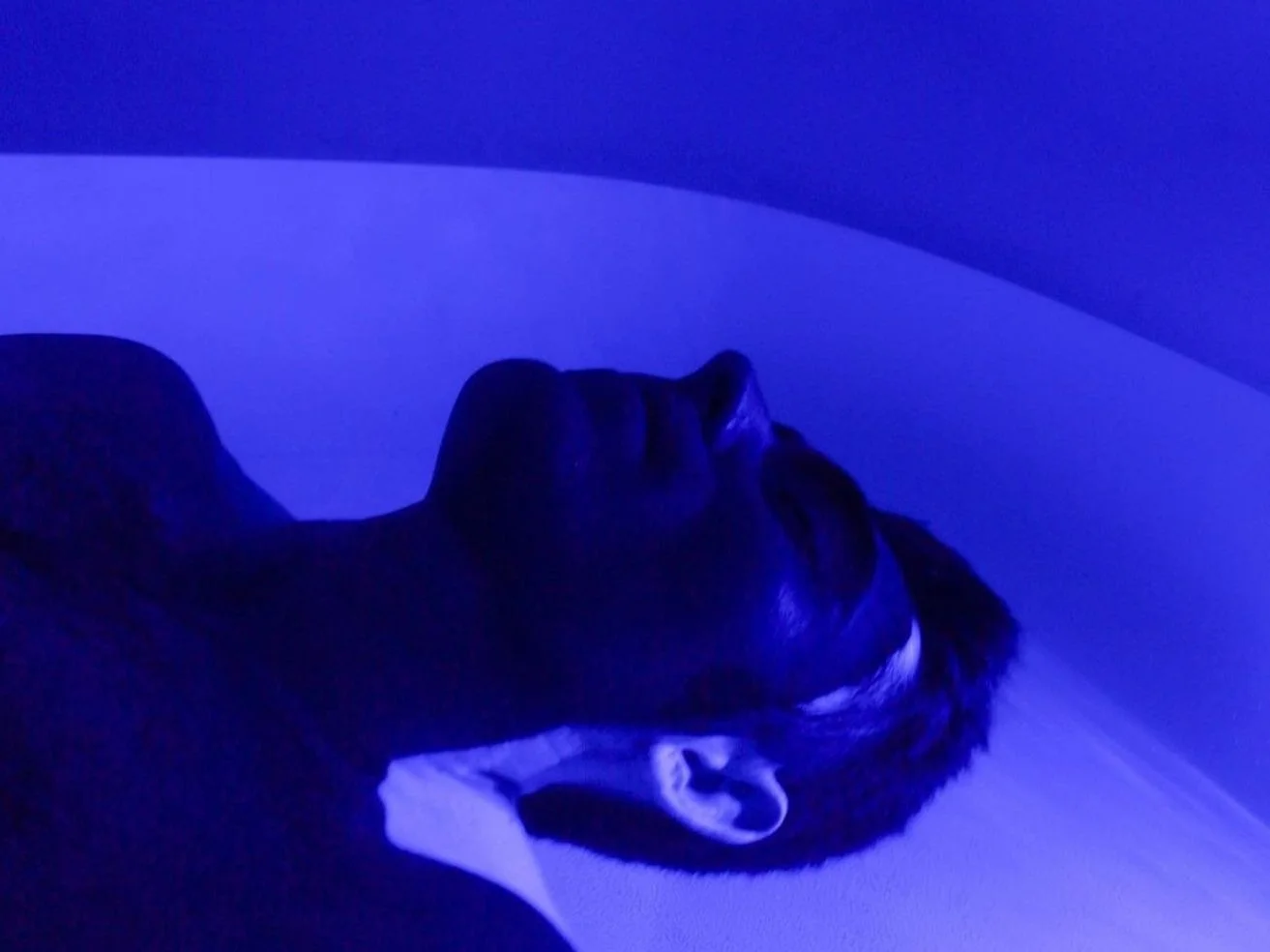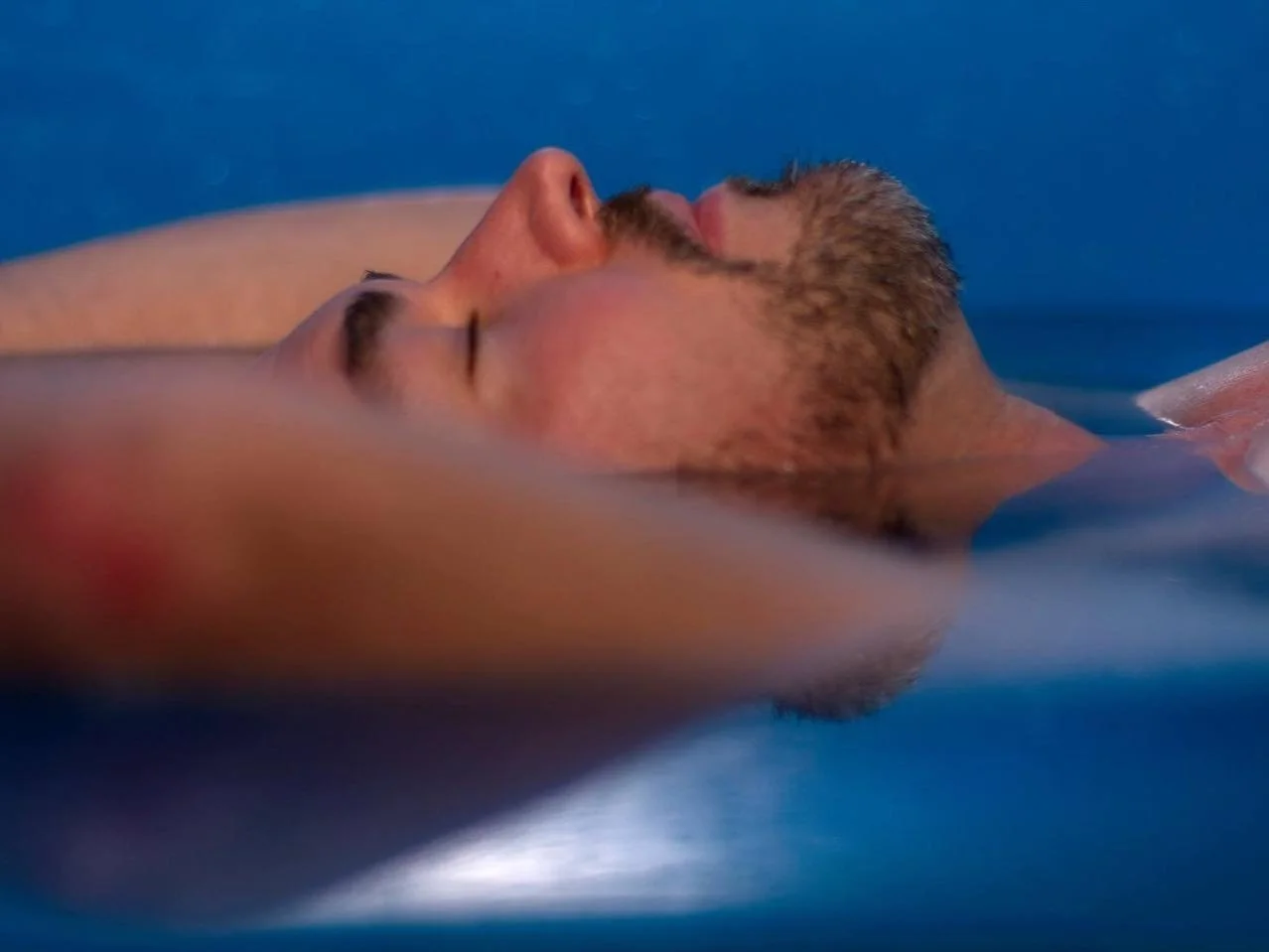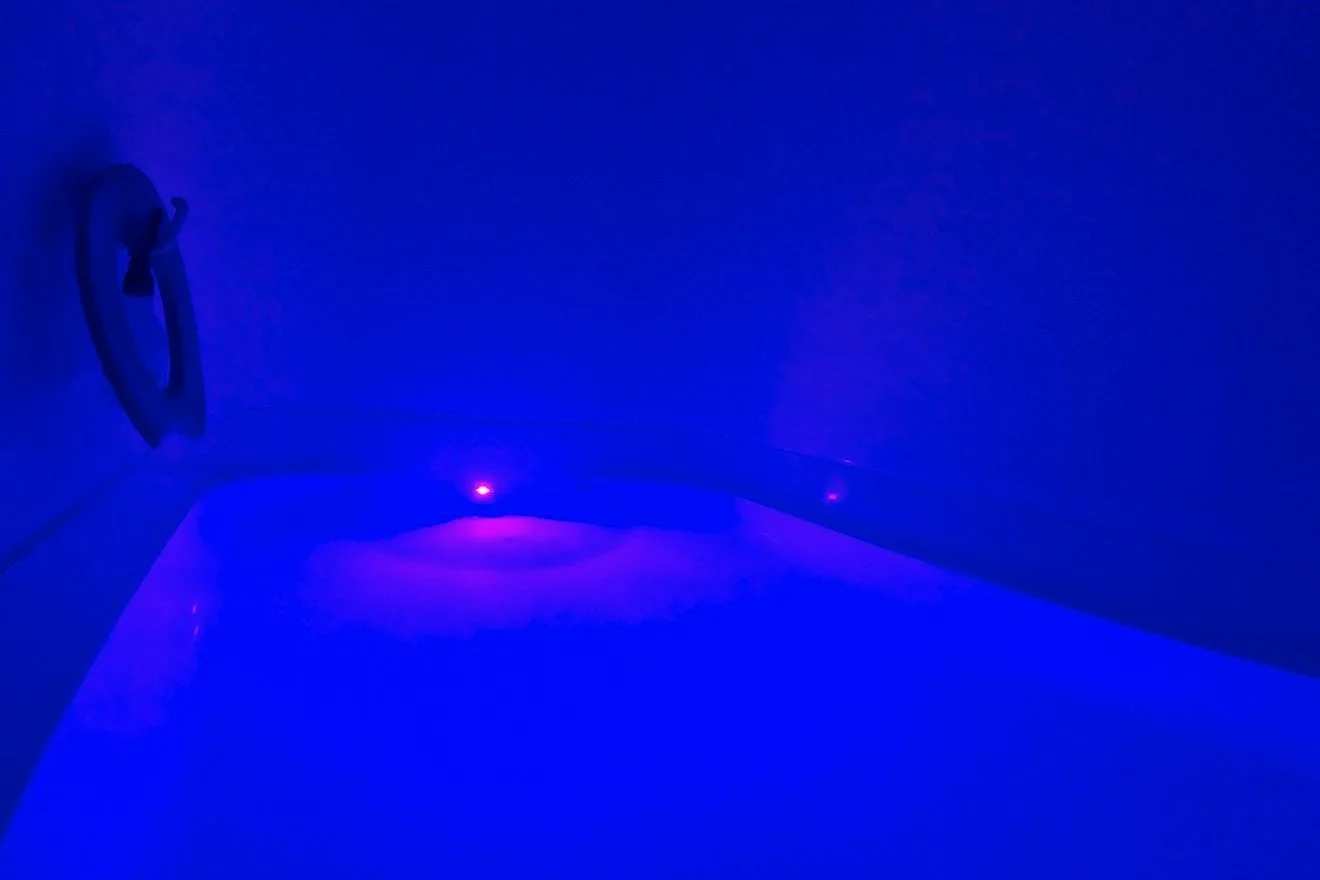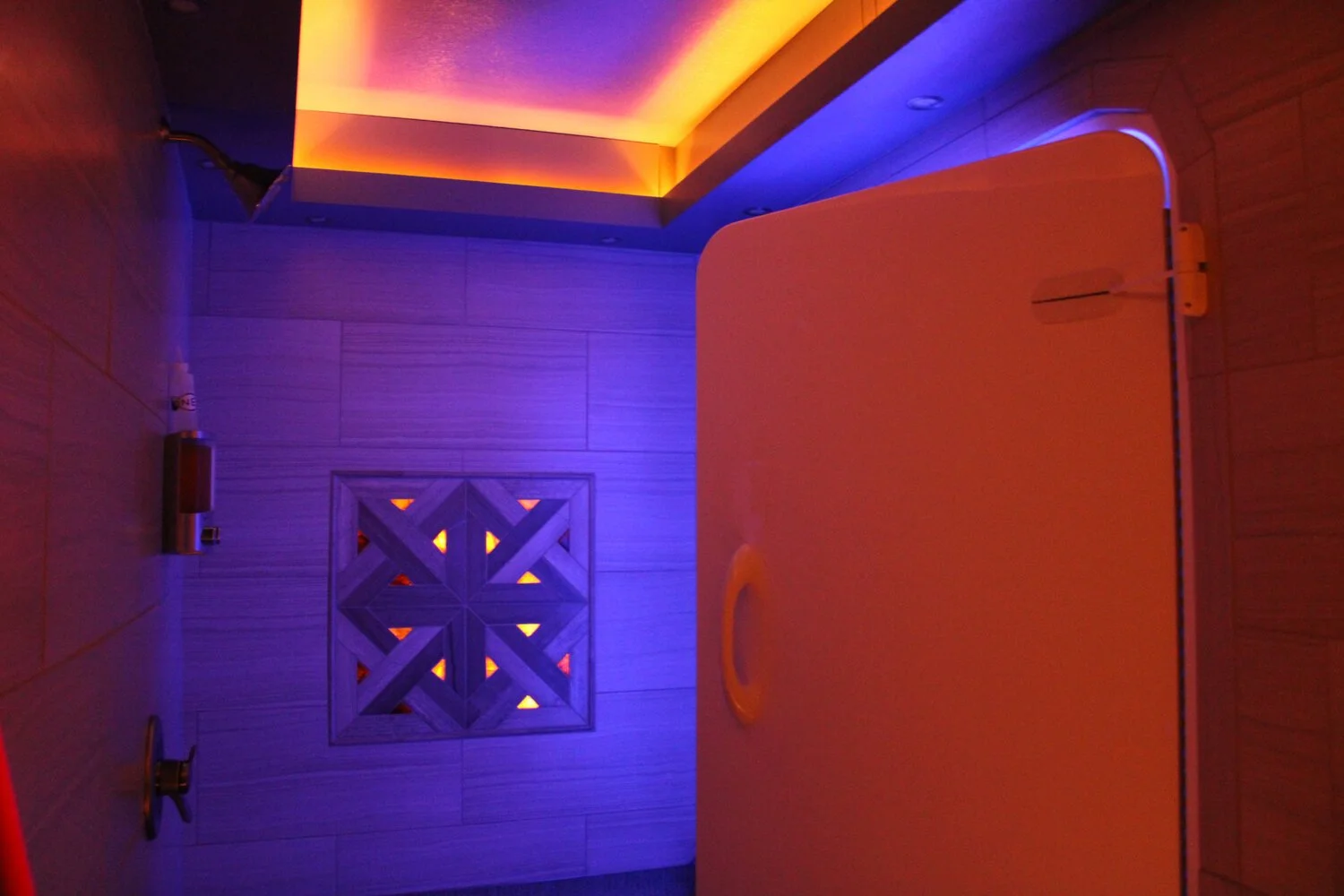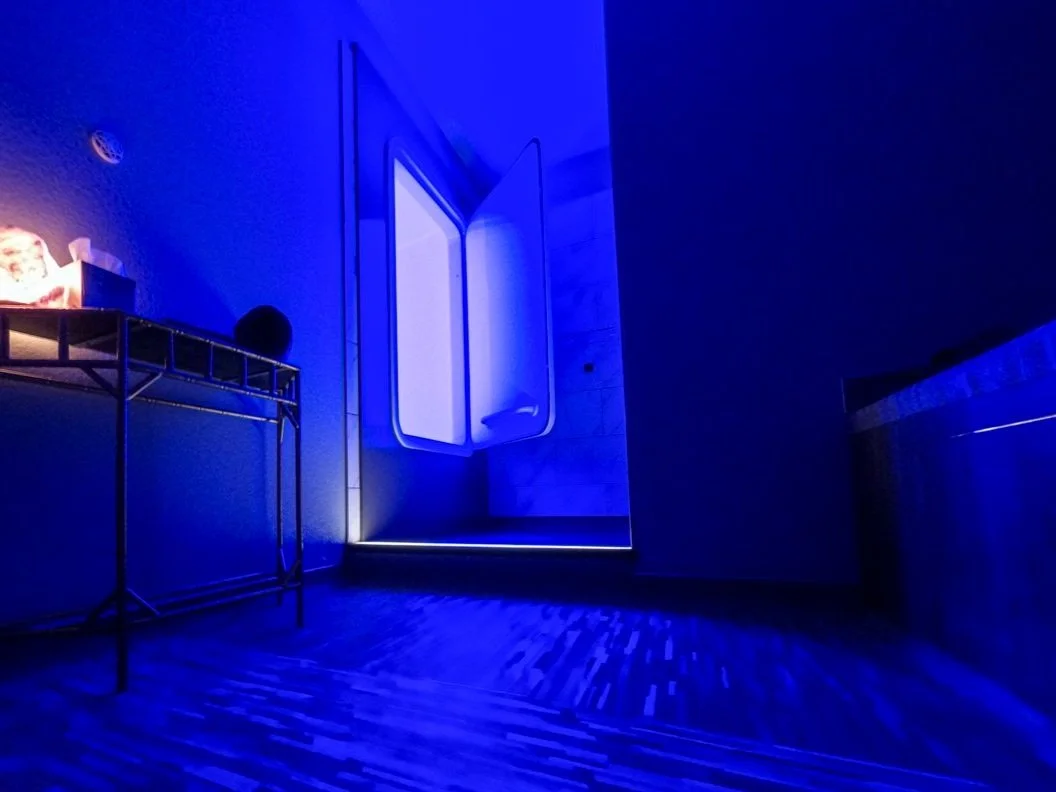
Discover Floatation Therapy
Float Into a Serene & Rejuvenating Space, Where Peace Surrounds You
What is Floatation Therapy?
Come float with us! Our float tanks (also called sensory deprivation or isolation tanks) are enclosed in private suites. Each tank has 11" of water and 1,000+ pounds of pharmaceutical grade Epsom salt. The air and water are heated to body temperature and the experience is totally silent and sightless.
Our tanks have a variety of shapes and sizes, but all offer a rejuvenating experience that lessens your physical boundaries and are free to let your mind drift into a meditative state of nothing. Each float suite has its own private shower so you can shower before and after your session in maximize comfort.
The floating experience benefits health, spiritual development, and overall personal well-being. The practice has been shown to enhance muscle recovery, musculoskeletal awareness, immune function, and lower cortisol to increase stress resistance. With the removal of (almost) everything, your body has extra resources to apply to areas where you need a little extra love. Cortisol (our stress hormone) has been shown to be reduced for extended periods after floats, as well an increase in Theta brainwave frequency (rather than Alpha or Beta). Theta brainwave frequency is most commonly associated to the same state your brain is in when you meditate.
Restricted Environmental Stimuli Therapy (REST) is a common term used by the scientific community. Floating or R.E.S.T. provides an environment ideal for relaxation and healing, which is why it has become increasingly studied over the past 30 years. Currently this technique is undergoing clinical research trials as an effective way to mitigate anxiety. The Epsom salt (Magnesium Sulfate) is great for helping sore muscles recover, so this is also becoming increasingly popular for professional athletes as a part of their recovery process.
The Benefits of Floating
MIND
Reduces Stress
Improves Mental Clarity
Boosts Creativity
Alleviates Anxiety
Regulates Mood
Induces a Quiet/No Think Space
BODY
Relieves Muscle Tension
Reduces Pain & Inflammation
Improves Circulation
Supports Recovery
Calms the Nervous System
Enhances Athletic Performance
SOUL
Encourages Deep Relaxation
Stimulates Theta Brainwaves
Increases Creativity
Supports Deep, Restorative Sleep
Expands Awareness
Fosters a Sense of Oneness
Floating FAQs
-
Avoid coffee or any caffeinated beverage for several hours beforehand (it could make you a bit jittery), as well as avoid shaving or waxing a day or two before - the saltwater can irritate your skin if you have done so. Eating a light meal about an hour to 90 minutes ahead of time stops your stomach from sounding like an angry monster while you float, and it is always a good idea to be well hydrated. Other than that, there’s no specific preparation needed.
-
If you have longer hair, you may want to bring a comb or brush. If you plan on removing your contacts, please be sure to bring something to put your contact lenses into while you’re in the tank. We provide everything you need (towels, robe, earplugs, body wash, shampoo, conditioner, etc.) There’s no need to bring a swimsuit as our guests float in the nude.
-
Being in the tanks is more like floating in outer space than being shut in a box. You’re always in control of your environment, and even people with extreme claustrophobia have reported having no problems with their time in the tank. Plus, we now have an Open float room to give you some extra open space if needed.
-
Yes. Just follow the same protocol you would for use of a swimming pool.
-
Like a pickle covered in maple syrup, pregnant women LOVE floating! There is even special positions you can float in that will help relieve all of the weight of the baby off of the mother’s body. If you are in your third trimester or have any concerns, please consult with your physician before coming in.
-
While there is no guarantee that the salt won’t strip some color from your hair, we recommend that you check if the water running through your hair in the shower at home is fully clear. If there is still some color coming out, you should wait a couple of more days/showers. Typically, after three full wash-throughs, you should be fine to float.
-
Only one person per tank. Double-wide tanks do exist, but we think that they take away from the whole ‘sensory deprivation’ experience.
-
- General stress and anxiety reduction all the way down to a hormonal level (especially following multiple sessions)
- Enhances cognitive processes involved with creativity and problem solving -
Borrie, R. and Peter Suedfeld. (1980) Restricted environmental stimulation therapy in a weight reduction program. Journal of Behavioral Medicine, vol 3, 147-161
Forgays, Donald. (1987) Flotation REST as a smoking intervention. Addictive Behaviors, vol 12, 85-90
Forgays, Donald, Deborah Forgays, Miki Pudvah, Drex Wright. (1991) A direct comparison of the wet and dry flotation environments. Journal of Environmental Psychology, vol 11, 179-187
Forgays, D. and Deborah Forgays. (1992) Creativity enhancement through flotation isolation. Journal of Environmental Psychology, vol 12, 329-335
Forgays, D. and Deborah Forgays. (1994) The use of flotation isolation to modify important type-A components in young adults. Journal of Environmental Psychology, vol 14, 47-55
Forgays, D. and Maureen Belinson. (1986) Is Flotation Isolation a Relaxing Environment? Journal of Environmental Psychology, vol 6, 19-34
Hutchison, Michael. (1984) The Book of Floating. The Brainwave Explanation. William Morrow and Companym New York, NY, p 53-58
Norlander, T. Henrik Bergman and Trevor Archer. (1998) Effects of flotation rest on creative problem solving and originality. Journal of Environmental Psychology, vol 18, 399-408
Rogan, A. Rony Morris, and Peter Gibbons. (2001) Pain management in osteopathic medicine: the efficacy of flotation REST as an adjunct to spinal manipulation for acute non-specific low back pain. A case report. Journal of Osteopathic Medicine, vol 4, 25-30
Rubik, Beverly. (2011) Neurofeedback-enhanced gamma brainwaves from the prefrontal cortical region of meditators and non-meditators and associated subjective experiences. The Journal of Alternative and Complementary Medicine, vol 17, 109-115
Shulz, P. and Charles-Henry Kaspar. (1994) Neuroendocrine and psychological effects of restricted environmental stimulation technique in a flotation tank. Biological Psychology vol 37, 161-175
Suedfeld, Peter. Chuni Roy, and P. Bruce Landon. (1982) Restricted environmental stimulation therapy in the treatment of essential hypertension. Behavior Research and Therapy, vol 20, 553-559
Suedfeld, P. Daniel Steel, Alistair Wallbaum, Susan Bluck, Nigel Livesey and Lorianna Capozzi. (1994) Explaining the effects of stimulus restriction: testing the dynamic hemispheric asymmetry hypothesis. Journal of Environmental Psychology, vol 14, 87-100
Suedfeld, P. Elizabeth Ballard and Margaux Murphy. (1983) Water immersion and flotation: from stress experiment to stress treatment. Journal of Environmental Psychology, vol 3, 147-155
Suedfeld, P. Janet Metcalfe and Susan Bluck. (1987) Enhancement of scientific creativity by flotation REST (restricted environmental stimulation technique). Journal of Environmental Psychology, vol 7, 219-231
Turner, J. and Thomas Fine. (1983) Effects of relaxation associated with brief restricted environmental stimulation therapy (REST) on plasma cortisol, ACTH, and LH. Biofeedback and Self-Regulation, vol 8, 115-126
Van Dierendonck and Jan Te Nijenhuis. (2005) Flotation restricted environmental stimulation therapy (REST) as a stress management tool: a meta-analysis. Psychology and Health, vol 20, 405-412
Walker, W. Rand, Robert Freeman, Daniel Christensen. (1994) Restricting environmental stimulation (REST) to enhance cognitive behavioral treatment for obsessive compulsive disorder with schizotypal personality disorder. Behavior Therapy, vol 25, 709-719
Watch Our First-Time Floater Video
For reservations or information:
Please call our studio at
775-499-5393 or book online.

